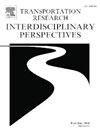“I trust Norway” – Investigating acceptance of shared autonomous shuttles using open and closed questions in short-form street interviews
IF 3.9
Q2 TRANSPORTATION
Transportation Research Interdisciplinary Perspectives
Pub Date : 2025-04-12
DOI:10.1016/j.trip.2025.101414
引用次数: 0
Abstract
Shared autonomous shuttles (SASs) could improve the mobility infrastructure in the worlds’ growing cities. This novel service could reduce congestion and improve both mobility and sustainability. To facilitate the implementation of SASs, more research is needed on the psychological aspects of sharing a small, intimate shuttle with strangers. The current study is among the first to use open-ended questions to investigate SAS acceptance. This investigation is based on the Multi-Level Model on Automated Vehicle Acceptance (MAVA). We had 236 participants answer short-form interviews including both open-ended questions and quantitative items. Quantitative data were analyzed using descriptive statistics and correlations, and qualitative data analyzed with directed content analysis. Respondents seem very positive about the proposed new transport service. We found that perceived usefulness, hedonic motivation, trust, and social influence shared large correlations with intentions to use. Other factors such as demographics, technology savviness and use of public transport did not share a linear relationship with intentions to use. Qualitative analysis suggests that, while most people do not mind sharing shuttles with strangers, some could find the social situation deterring. People seem most concerned with availability, effectiveness, travel cost and safety. The reported positive attitudes towards the service seem predicated upon trust in the government regulation and proper testing of the technology, that many think of as immature. Regulation and thorough testing may be paramount in keeping people positive. This study emphasizes the importance of trust and safety to adoption of SAS, while suggesting new factors that need further investigation.
“我相信挪威”——在简短的街头采访中,用开放和封闭的问题调查人们对共享自动驾驶班车的接受程度
共享自动驾驶班车(SASs)可以改善世界上不断发展的城市的交通基础设施。这种新颖的服务可以减少拥堵,提高机动性和可持续性。为了促进SASs的实施,需要对与陌生人共享小型亲密班车的心理方面进行更多的研究。目前的研究是第一个使用开放式问题来调查SAS接受度的研究。本研究基于多级自动车辆验收模型(MAVA)。我们让236名参与者回答简短的访谈,包括开放式问题和定量项目。定量数据采用描述性统计和相关性分析,定性数据采用定向内容分析。受访者似乎对拟议中的新运输服务持积极态度。我们发现感知有用性、享乐动机、信任和社会影响与使用意图有很大的相关性。其他因素,如人口统计、技术熟练程度和公共交通的使用与使用意图没有线性关系。定性分析表明,虽然大多数人不介意与陌生人共用班车,但有些人可能会觉得这种社会状况令人望而却步。人们似乎最关心的是可用性、有效性、旅行成本和安全性。据报道,人们对这项服务的积极态度似乎是基于对政府监管的信任和对这项技术的适当测试,而许多人认为这项技术还不成熟。监管和彻底的检测可能是保持人们阳性的最重要因素。本研究强调了信任和安全对SAS采用的重要性,同时提出了需要进一步研究的新因素。
本文章由计算机程序翻译,如有差异,请以英文原文为准。
求助全文
约1分钟内获得全文
求助全文
来源期刊

Transportation Research Interdisciplinary Perspectives
Engineering-Automotive Engineering
CiteScore
12.90
自引率
0.00%
发文量
185
审稿时长
22 weeks
 求助内容:
求助内容: 应助结果提醒方式:
应助结果提醒方式:


